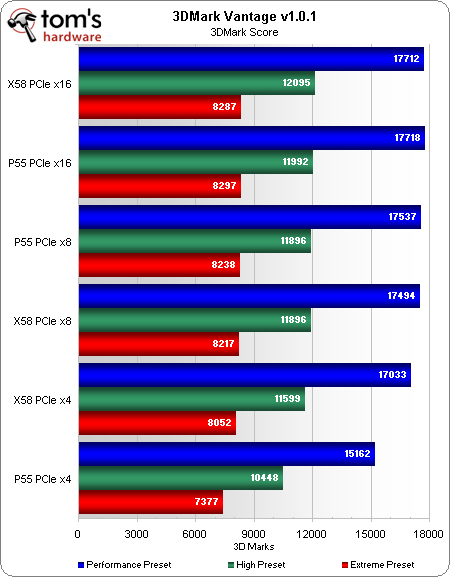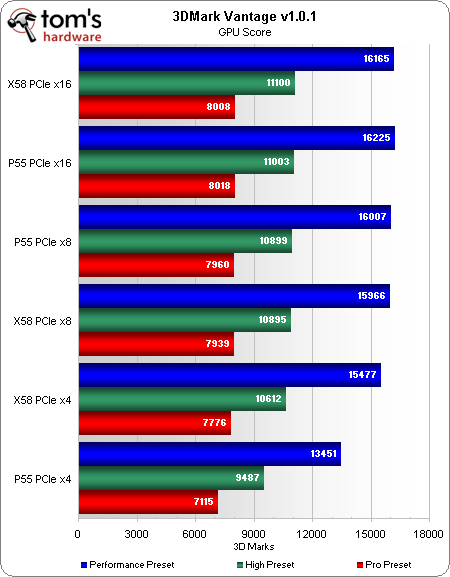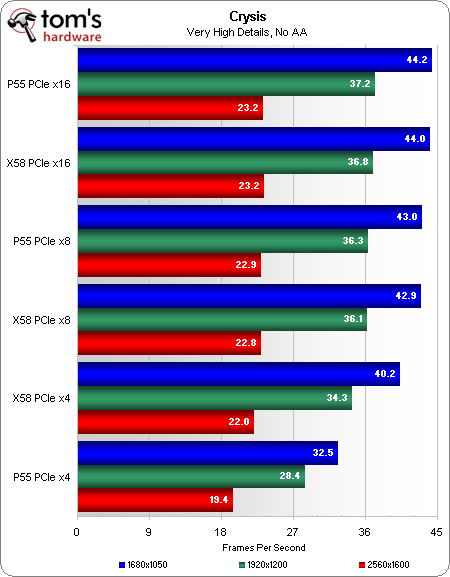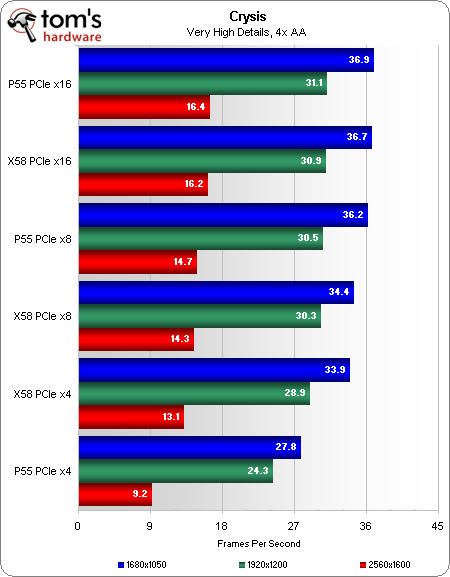PCI Express And CrossFire Scaling: Is P55 Good Enough?
PCIe Scaling Results: 3DMark And Crysis
A pure synthetic benchmark, 3DMark’s results often reflect computational power more effectively than other things, such as memory bandwidth and response time, which can often affect actual games.
There doesn’t appear to be much performance difference between x8 and x16 slots, though the X58’s PCIe 2.0 x4 slot certainly outperforms the P55’s 2.5 GT/s version.
All of the performance differences found in 3DMark’s system score can also be seen in its GPU score.
As an unbearably difficult-to-render game that few people actually play, Crysis is the real-world benchmark that fills the gap between more popular games and pure synthetics. Like 3DMark, it shows only minor losses going from x16 to x8 mode while giving the X58’s 5.0 GT/s x4 link a huge lead over the P55’s 2.5 GT/s version.
Activating anti-aliasing (AA) makes the difference between slot bandwidth even more visible, but just as noticeable is the fact that none of these settings play smoothly, even with an ultra-fast Radeon HD 5870 graphics card and a 4.0 GHz Core i7 CPU.
Get Tom's Hardware's best news and in-depth reviews, straight to your inbox.
Current page: PCIe Scaling Results: 3DMark And Crysis
Prev Page Test Configuration Next Page PCIe Scaling Results: Far Cry 2 And H.A.W.X.-
gilbertfh I just ordered myself an ASUS P7P55D-Pro and didn't understand the difference... If I spent $1200 on video cards to go in this bad boy expecting it to test at higher performance that I will never be able to see by the naked eye it may have been a bigger deal(but it isn't).Reply -
gkay09 It is pretty logical to go the X58 route if you are planning for more than 2 cards...Reply
Only 2x HD 5970s would have significant bottleneck with x8x8 config of the P55...for rest of the cards, the x8x8 still would suffice... -
jsc For most of us, it looks like the P55 is the way to go for a gaming machine. I was a little surprised at how well two X8 channels did.Reply -
neiroatopelcc Does it make a difference for the motherboard wether or not all slots are populated when we talk energy? Each pcie plug is supposedly able to deliver 75W to the cards right? so at 3 cards that's quite a bit of power. In addition it has to deliver what, 140W? to the 4ghz cpu .... remembering an earlier article detailing failed boards because of inadequate vrm's I just have to wonder if a higher power draw on the pcie connectors would make a difference in sustainability with such an oc? I mean at some point I would assume a board can draw more power than the atx connector or the power plane can handle?Reply -
a4mula pcie 2.0 supports up to 300w (1.1 was 75w). The 5870 draws about 170w at load. This was the reason the 5970 was scaled back to 5850 speeds. Overclocked 920 @ 4.0 is going to draw about 250w. i5 750 (@ 4.0) on the other hand draws about 150w.Reply
For awhile now it's been known that the p55 will run an 8x8x crossfire within close proximity of it's x58 16x/16x even on 5870's. The only real question that hasn't been seen is the quadfire 5970's and a trifire 5970+5870. Publish that and you'll garner my attention at least. -
neiroatopelcc 300w ? but why then would new cards still ship with pcie6 and 8 connectors if the cards actually could make do with the pcie supplied power? I mean, sure for pcie1 support, but won't they still bitch if one was to not plug em in under pcie2?Reply
ps. 150W is also a lot for a processor designed for two digit numbers. Is there some kind of list somewhere of which motherboards support how much vrm power, or how many phases generate how much wattage or whatever can be used as a guideline?
Gonna upgrade the p35 to p55, and I've never been one for stock speeds... -
jennyh The gap is just going to increase with more and more powerful graphics cards. We're talking 1-2 years and 8x will be performing just like 4x is now.Reply
8x Pci-e lanes should now be considered a drawback when purchasing new hardware. -
notty22 "8x Pci-e lanes should now be considered a drawback when purchasing new hardware."Reply
They just proved it was NOT a drawback with two 400 dollar top tier gpu's.
Someone that advocates not upgrading the rest of their motherboard specs to the current high performance components such as DDR3 and the fastest hypertransport speed should not worry about THEORETICAL pci-e bandwidth. -
baracubra Yeaaaaah! I've been waiting for this article for quite a while now, this clears up a lot of speculation! I hope you guys do a follow-up article to test whether two 8x,8x are enough to support 2x 5970's....Reply
If this article had come out 2 weeks ago, I would have upgraded to an i7-870 and 2x 5870's, but now that we know Fermi is arriving in Q1 2010 I'm afraid i'm gonna have to wait. . . again -.-
Oh well, that's why we love the PC market, always advancing :)




